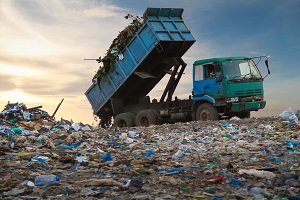
Pollution Considerations for Waste Management & Recycling Companies
Waste management and recycling operations play an important role in both public and environmental health. These facilities can house, process, and dispose of waste and recycled goods, which means the protocol for handling potentially hazardous or toxic substances should be part of their overall loss control plan. Although waste management and recycling are heavily regulated, it is critical for companies to have the right insurance in place to prevent a pollution loss.
Pollution Concerns for Waste Management and Recycling Facilities
Pollution concerns at waste management/recycling facilities vary according to the sources of the waste/material, the type of recycling that takes place at the facility, the historical use of the site, the surrounding environment, whether or not containment for the materials reaches a certain level, and whether or not environmental management practices are implemented.
Unless there is comprehensive screening of the incoming materials, hazardous materials may be introduced into the waste or recycling stream. For example, paints, chemicals, metal, building materials, and other potentially hazardous items may prove to be toxic, contain asbestos residues, saturated with oil or other chemicals, etc. It’s also possible that discarded electrical equipment may contain lead, dioxin, or cadmium.
The following pathways are potential sources of liability for waste management/recycling operations:
Soil: Facilities are often located in areas that have had a history of industrial activity. Very often these facilities have been used as waste facilities in the past, so there is a high probability that the soil has been impacted by various hazardous and non- hazardous chemicals. The material handling systems at these facilities may also contribute to soil contamination. Spills may occur during draining and transfer of vehicle fluids, parts cleaning from fuel tanks, faulty electrical switches may release mercury, and damaged or worn bearing housings may release hydraulic fluids or oils.
Air: Hazardous air emissions may be released when metals and other waste are cut with torches or fires erupt from chemicals or fuels that have been disposed of. In the past few years, there have been many news stories about air emission studies in the vicinity of waste/recycling facilities that show elevated levels of toxic air contaminants. In addition, dust and fumes from these facilities have been known to drift into surrounding communities.
Wastewater/Storm Water Discharge: The Environmental Protection Agency (EPA) requires that some waste and recycling facilities obtain stormwater discharge permits. In order to secure a permit, these facilities must develop controls to minimize the discharge of potential sources of pollutants from their sites. They may do this by developing operating procedures that will minimize the release of pollutants and conduct inspections at their facilities to ensure that their standard operating procedures are adhered to by their employees. For example, they might use tarps to cover their bins and containers. In spite of the best controls, tarps may rip or be removed by the wind, inspections may not be as thorough as required, structures with only a roof may not keep out as much precipitation as needed, costs may prohibit the building and design of complex structures and illicit, or improper drainage systems (in the facility on the tipping floor or outside of the facility) may result in discharges to storm sewer systems.
For more on waste management and recycling facilities, including product information and claim scenarios, contact us.
The following sources were used in this post:
Type: Blog